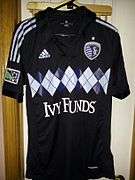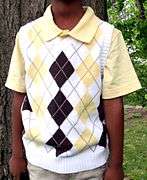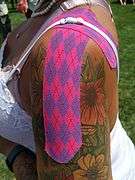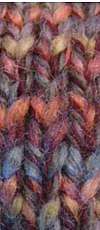Argyle (pattern)

An argyle (occasionally argyll) pattern is made of diamonds or lozenges. The word is sometimes used to refer to an individual diamond in the design, but more commonly refers to the overall pattern. Most argyle contains layers of overlapping motifs, adding a sense of three-dimensionality, movement, and texture. Typically, there is an overlay of intercrossing diagonal lines on solid diamonds.
The argyle pattern derives from the tartan of Clan Campbell, of Argyll in western Scotland,[1] used for kilts and plaids, and from the patterned socks worn by Scottish Highlanders since at least the 17th century (see illustrations in History of the kilt). These were generally known as "tartan hose".[2][3]
Argyle knitwear became fashionable in Great Britain and then in the US after the First World War of 1914–1918. Pringle of Scotland popularised the design, helped by its identification with the Duke of Windsor[4]. Pringle's website says that "the iconic Pringle argyle design was developed" in the 1920s.[5] The Duke, like others, used this pattern for golf clothing: both for jerseys and for the long socks needed for the plus-fours trouser fashion of the day.
Payne Stewart (1957–1999), who won the U.S. Open in 1991 and 1999 and the PGA championship in 1989, was known for his flashy tams, knickerbockers, and argyle socks.[6]
As a knitting pattern, argyle is generally accomplished using the intarsia technique. Argyle patterns are occasionally woven.
Some sports teams use bright, contemporary interpretations of the argyle pattern: for example, the Garmin-Slipstream professional cycling team, nicknamed the "Argyle Armada", and the Norwegian men's curling team at the 2010 Winter Olympics.[7] On April 27, 2013 the professional soccer team Sporting Kansas City of Major League Soccer (MLS) in the United States announced their third kit of the 2013 season, featuring an argyle pattern.[8] The University of North Carolina has used the argyle pattern for its basketball uniforms since 1991, and introduced it as alternate for all sports uniforms in 2015. [9] The Belgian soccer national team used such design in the 1984 European Cup, and has now a new version of it for the 2018 World Cup in Russia.
Gallery
.png)



See also
| Look up argyle in Wiktionary, the free dictionary. |
References
- ↑ Oxford English Dictionary
- ↑ See, for example, Provost Cochrane's letters to the Duke of Argyle in Jan 1746, published in Cochrane's Correspondence, 1836, available at Google Books
- ↑ http://www.tartansauthority.com/highland-dress/modern/hose
- ↑ Hodgkinson, Mark (2004-07-15). "Diamonds are for heather – and all parts of a golf course now Pringle's back". The Daily Telegraph. London. Retrieved 2010-04-25.
- ↑ http://www.pringlescotland.com/
- ↑ "Stewart, Payne (1957–1999)." Newsmakers. Ed. Aaron J. Oppliger. Detroit: Gale Group, 2000. Discovering Collection. Gale. ARKANSAS STATE LIBRARY – TRAVELER. 24 Mar. 2009
- ↑ Bracken, Kassie (2010-02-14). "The Curling Lords of Argyle". The New York Times.
- ↑ http://www.sportingkc.com/news/2013/04/sporting-kc-unveils-third-kit-presented-ivy-funds
- ↑ https://www.si.com/college-football/2015/04/20/north-carolina-football-uniforms-argyle



.svg.png)